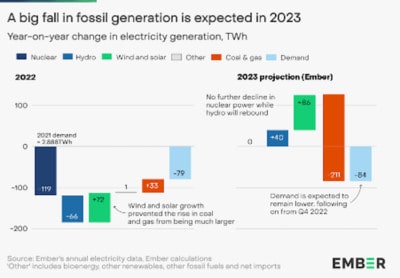Even at the start of 2022, it was clear something was afoot in Europe’s power sector. Gas prices had risen sharply by autumn 2021 and continued to stay high.
When Russia invaded Ukraine in February last year, the extent of the challenge became clear. The European Union would have to engineer a shift, rapidly and fundamentally, in how it generates electricity—or leave itself vulnerable to energy blackmail as well as extremely volatile fossil-fuel prices.
Clean-energy surge
In the wake of the invasion, there was speculation that a scramble for emergency measures to secure supplies would stall Europe’s decarbonisation. Could this moment of crisis mark a return to coal?
This though failed to materialise. Instead the EU elected to address multiple vulnerabilities by accelerating the transition to green electricity. There is now a focus on rapidly cutting gas demand while simultaneously phasing out coal. A surge of clean energy is on its way.
Indeed, analysis of full-year EU generation and demand data, released today by Ember, shows this shift is already happening. In 2022, wind and solar power generated a record fifth of EU electricity (22 per cent), for the first time overtaking fossil gas (20 per cent) and remaining above coal (16 per cent).

Double challenge
Europe however faced last year a double challenge in its electricity system, which slowed the move from fossil fuels. A one-in-500-year drought led to the lowest hydro generation since at least 2000. Nuclear meanwhile fell, with widespread, unexpected nuclear outages in France and German units reaching planned closure dates.
The drop in hydro and nuclear resulted in a gap of 185 terawatt hours in generation, equal to 7 per cent of Europe’s total electricity demand in 2022. This was largely met by increased wind and solar and a fall in demand. But a sixth of the deficit was assuaged by increased fossil generation.
With gas prices continuing to hit records, coal accounted for most of this increase, with a 7 per cent (28 TWh) rise on 2021. This meant EU power-sector emissions also increased in 2022, by 3.9 per cent.
While fossil-gas supplies and prices dominated news cycles, gas generation remained almost unchanged in 2022, rising just 0.8 per cent year-on-year. Any switching from gas to coal had already taken place the previous year, when gas had already become more expensive.
Weathering multiple crises
This perhaps obscures how well Europe’s power system managed to weather a year of multiple crises. Growth in wind and solar, alongside a fall in electricity demand, prevented a much larger return to coal amid the nuclear and hydro deficit. The increase in coal was relatively minor, with just a 1.5 percentage point rise to generate 16 per cent of EU electricity in 2022, below 2018 levels. This 28TWh rise in EU coal generation added only 0.3 per cent to the global statistic.
Even this slight increase looks very temporary. By the end of the year, coal power was rapidly dropping amid falling electricity demand. It fell for all four of the final months of 2022, with generation down 6 per cent from September to December compared with the same months of 2021.
Much was made of the 26 coal units brought back as emergency standby but they ran at just 18 per cent average utilisation throughout the last three months of 2022, with nine providing no power at all. They added only 0.9 per cent to EU coal generation last year. And, tellingly, member states maintained commitments to coal phase-out, in some cases accelerating their ambition.
Fundamentally changed
We predict that 2023 will show a fundamentally changed EU power sector. With hydro and nuclear generation returned, alongside continued suppressed demand, Europe is set for a huge fall in fossil fuels. Fossil generation could slump by 20 per cent in 2023, double the previous record fall in 2020.

Gas generation is projected to remain more expensive than coal until at least 2025. As wind and solar deployment accelerate, they will displace not only coal but gas too. The power sector is likely to be the fastest-falling segment of gas demand during 2023, bringing relief to Europe’s gas markets as it settles into its new electricity-system paradigm—one without Russian gas, and with a whole lot more clean power.
Dave Jones is head of data insights at Ember, which he helped to launch in 2020, and lead author of its Global Electricity Review. He previously worked as an electricity-trading analyst for the German utility E.ON before joining the non-profit Sandbag, where he worked on phasing out coal in Europe.

